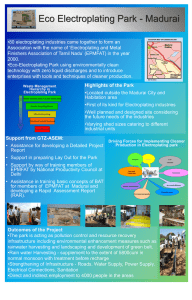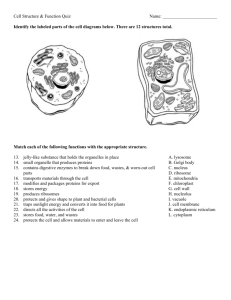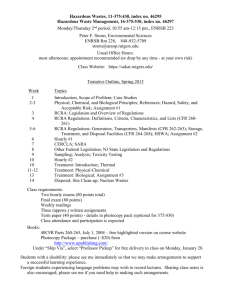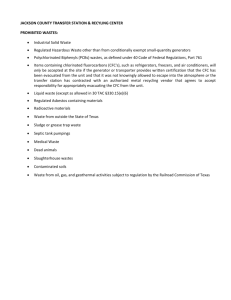Regulatory Approaches for Metals Reclamation Rule
advertisement
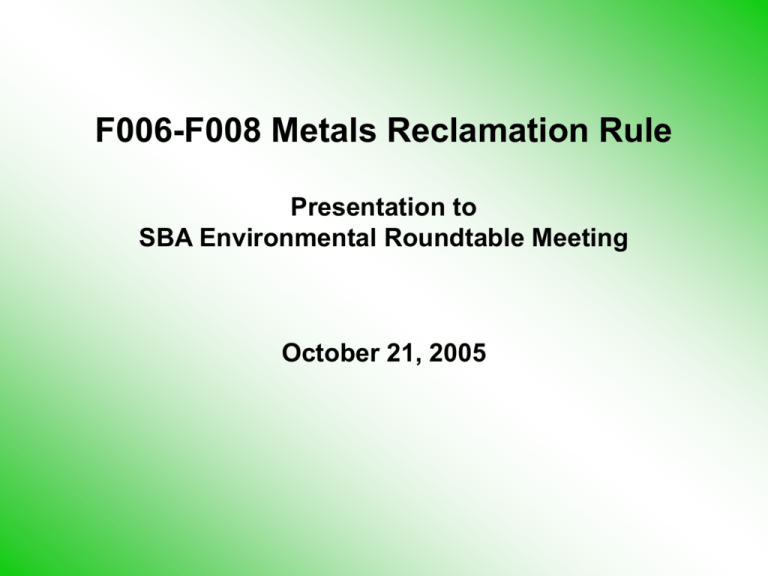
F006-F008 Metals Reclamation Rule Presentation to SBA Environmental Roundtable Meeting October 21, 2005 Purpose of Briefing • Describe F006-F008 regulatory options under evaluation by EPA • Identify and discuss issues impacting options under evaluation • Discuss next steps 2 Rulemaking Objectives and Desired Outcomes - To encourage recycling of electroplating wastes by removing current regulatory disincentives to generators and handlers - To recover metal resources that otherwise would be land disposed 3 Outline of Presentation • • • • • Background Some statistics of interest Options under evaluation Issues Next steps and associated schedule 4 What are F006, F007 and F008 Wastes? • F006 - sludges (usually from filter press) from electroplating wastewater treatment processes F007 - spent cyanide plating baths from electroplating operations • F008 - plating bath residues from the bottom of plating baths from electroplating operations where cyanides are used in the process. 5 Why are these wastes listed? • F006 waste was listed for the hazardous constituents cadmium, hexavalent chromium, nickel, and complex cyanides. It also may contain lead, arsenic, and organics. – As part of listing process, the Agency identified damage incidents associated with contaminated wells, destruction of animal life that were attributable to the improper disposal of electroplating wastes. • F007 and F008 wastes were listed as hazardous wastes because each of the wastes exhibits either reactive or toxic properties, particularly because of their cyanide content. 6 How much electroplating waste is generated and recycled annually? - Total affected volume: 125,000 tons generated in 2001 - 50,000 tons recycled - 75,000 tons treated, stabilized or landfilled - 1,400 affected facilities (50 % are job shops or PWB producers) 7 What are the recoverable metals of concern? • Primarily Copper, Nickel and precious metals • To a lesser extent, chromium, zinc and tin 8 Currently Landfilled F006: Metal and F006 Volume By Metal Content Metal Concentration % of Landfilled F006 Volume 0–1% % of Metal in Landfilled F006 .6 % 1–2% .6% 6% 2–5% 2.3% 10 % 5 – 100 % 96.5% 67 % 17 % 9 Figure 1 The World of Electroplating Wastes Current System Hazardous Waste RCRA Subtitle C applies Generators Hazardous Waste Hazardous Waste RCRA Subtitle C applies RCRA TSDF Facility RCRA Reclamation Facility WRC Variance Generators Hazardous Waste Partial Reclaimer Commodity Like RCRA Subtitle C does NOT apply Non-RCRA Reclamation Facility Note: Ohio’s partial reclamation variance for Agmet (a consolidator) excluded F006 sludges10from DSW at the gate Proposed Regulatory Framework: Two Tiered system • Tier 1 – Conditional exclusion from the definition of solid waste (DSW) for commodity-like electroplating wastes Base Metal Minimum Concentration (dry weight, as generated) Copper 18% or equivalent in precious metals, or Nickel 12% or equivalent in precious metals Ion exchange systems used to treat wastewaters from electroplating operations sent off-site for canister and resin regeneration also excluded from DSW. 11 Tier 2: Alternative Subtitle C regulatory framework for recyclable electroplating wastes (Part 266) Base Metal Copper Nickel Minimum Concentration of Base Metal Contained in Electroplating Wastes (Dry weight, as generated) 1.4% 1.0% Or 12 Legal Rationale for Proposed system • Tier 1 – meets definition for commodity-like materials • Tier 2 – wastes legitimately recycled - at least 50% recovery rate 13 Conditions needed to satisfy exclusion from DSW for commodity-like materials • • • • • • • • Initial notification to EPA or authorized state Rejected loads Materials managed to minimize loss Normal business records, including a legally binding contract between pertinent parties, and analytical test results records Compliance with export & import requirements Compliance w/cyanide limitations Compliance with speculative accumulation requirements Meet slag residue limits at recycling facilities 14 Requirements that must be satisfied in order to manage recyclable electroplating wastes under Part 266 Generators - Same conditions as Commodity-like materials, plus - 180-Day accumulation time period - Exception reporting Handlers (Partial reclamation, primary mineral processing, secondary metals recycling and storage-only facilities) - - Co-Propose Two Options - RCRA Subtitle C storage permits - Closure plan and financial assurance in lieu of RCRA permit + Generator requirements 15 Alternative Approaches/Options Designed to foster greater flexibility • Rely on contract specifications rather than specified concentrations to determine commodity-like thresholds • Rely on range of concentrations, adjusted periodically, to determine commodity-like thresholds • Rely on facility records associated average annual slag concentrations • Rely on a mass balance approach to estimate metal recovery rates and associated useful contribution to recovery process • Expand the list of metals to include chromium, zinc and tin • Exclude from DSW all recyclable electroplating wastes providing a useful contribution to the recovery process 16 Issues of Concern • What additional amounts of copper and nickel (as well as other metals) will actually be recycled? • Will generators bite at Tier 2? Materials still a hazardous waste • Conditions and requirements – too prescriptive? OK? • How to address facilities that have adopted pollution prevention practices and no longer generate F006 waste stream with constituents or constituent levels of concern? • Cyanide: Is it a problem or not? Should concentration levels be risk-based? If so, what levels? • Role of Brokers and associated regulatory requirements • Consistency (or lack thereof) with potential ABR rulemaking 17 Current Status and Schedule Rule on Fast Track within Agency/OMB because of Thompson Report • Early January 2006 - Proposed rule published in Federal Register (FR) • March 2007 - Final Rule published in FR 18
